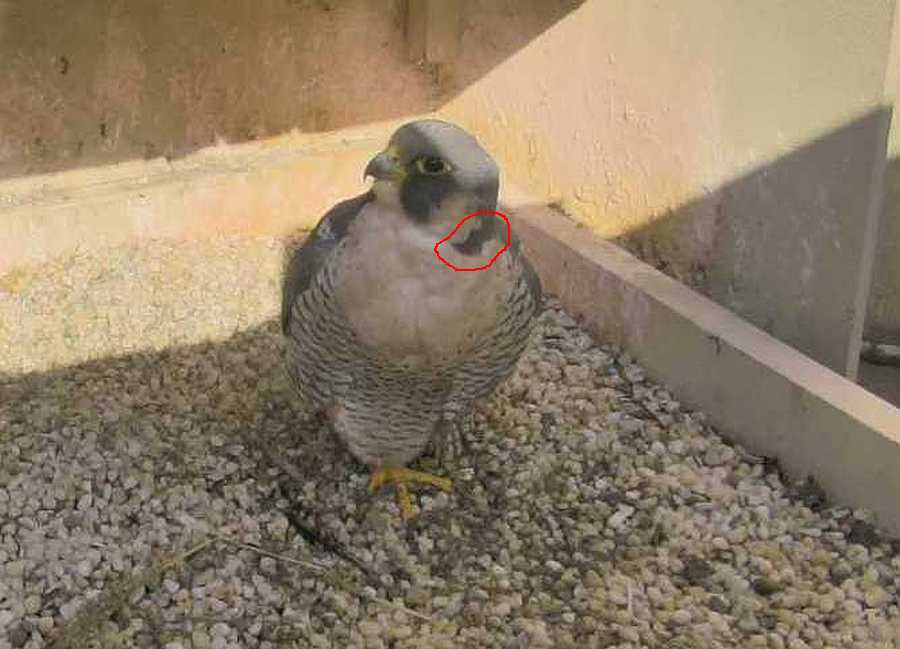
Now that the female peregrine, Morela, visits the Cathedral of Learning nest nearly every day you may be wondering how to identify her.
Here are her unique traits that you’ll see on camera, listed from easiest to hardest.
1. Morela has no bands on her legs. She often stands with her bare ankles showing.
2. All the normally white places on a peregrine — chest, face and cheeks — are peach-apricot on Morela. Even her belly beneath the stripes is peach-apricot, not white. This is noticeable in all photos.

3. Morela’s breast is clear with no spots or flecks of gray except at the edges (tiny flecks highlighted in photo below).

4. Peregrines have a broken necklace of charcoal gray that forms a frame on their cheeks below the malar stripe. Morela’s necklace is very wide when she turns her head, especially the necklace on her left side (necklace highlighted in photo below).

Morela shares some traits with other peregrines:
- Morela is much larger than Terzo. This is a female trait in peregrines.
- Morela’s forehead is pale where it meets her beak. Terzo has this trait, too, but Hope did not.
- Morela’s head and nape are quite dark. So are Terzo’s.
- There is very little color contrast between Morela’s head and back. This is typically a female trait in peregrines. Terzo has much more contrast — dark head, light gray back.

For comparison on camera here are two photos of Terzo in 2016 and 2017. Notice how white he is!


Watch for Morela on the snapshot camera. See if you can identify her.
p.s. Stay tuned on the National Aviary’s snapshot camera at the University of Pittsburgh. Streaming video from the National Aviary will resume in early 2020.
(photos from the National Aviary falconcam at Univ of Pittsburgh)
That is very interesting! Thank you.
Is there anything on what might have happened to Hope? Do females re-locate without their partners?
Helen, it is normal for individual peregrines to relocate without their partners. Here’s a summary of how it works (details at https://www.birdsoutsidemywindow.org/peregrine-faqs/question-fidelity-to-their-mates-and-fighting/)
Individual peregrines are more loyal to the nest site than they are to their mates. Couples do not defend each other against the opposite sex. It is up to the member of the same sex to chase off or fight an intruder. The winner gets the territory, the nest site, and the remaining peregrine as a mate.
Is it possible to band an adult peregrine, or will Morela remain unbanded? I like that she has so many unique features so that she will be easily identifiable on camera.
Chad, it is possible to band an adult peregrine but it has not been done in Pittsburgh for more than 20 years. Peregrines are no longer endangered so there is no longer a push to band them. In addition, we now know that they can be identified in photos — as explained in this blog post. Chad+Chris Saladin in Ohio take many photos of peregrines and are champions at identifying them that way.
I very much enjoyed that lesson.
Both are so beautiful. I love her peach as much as I love his snow white!
She is just beautiful.I love the Peach color on her! Thank you
I’m curious, are there are changes in color or markings as a Peregrine ages?
Scott, peregrine plumage changes from juvenile to adult at 1 to 2 years old — so that is a big change. I have seen adult males’ backs become paler over the years.
How fascinating! Thanks for sharing valuable and interesting information with accompanying photos— very helpful, Kate…
I think Morella is beautiful! Love her soft ‘hues’ and that will help us note the difference between her and her mate..Terzo is a handsome fella and they are both fairly young also? Both appear to be very healthy.
How old are Terzo and Morella? Hope?
Terzo: hatched in 2013, age 6 in April 2019.
Morela: We don’t know when & where she hatched because she is unbanded. She is a full adult of unknown age, at least 3 years old.
Hope: hatched in 2008, age 11 in April 2019.
The American ones look so pale to my Australian eyes. Ours don’t really have the white cheek so I have never looked at the necklace before. Very interesting! She’s a very cute bird.